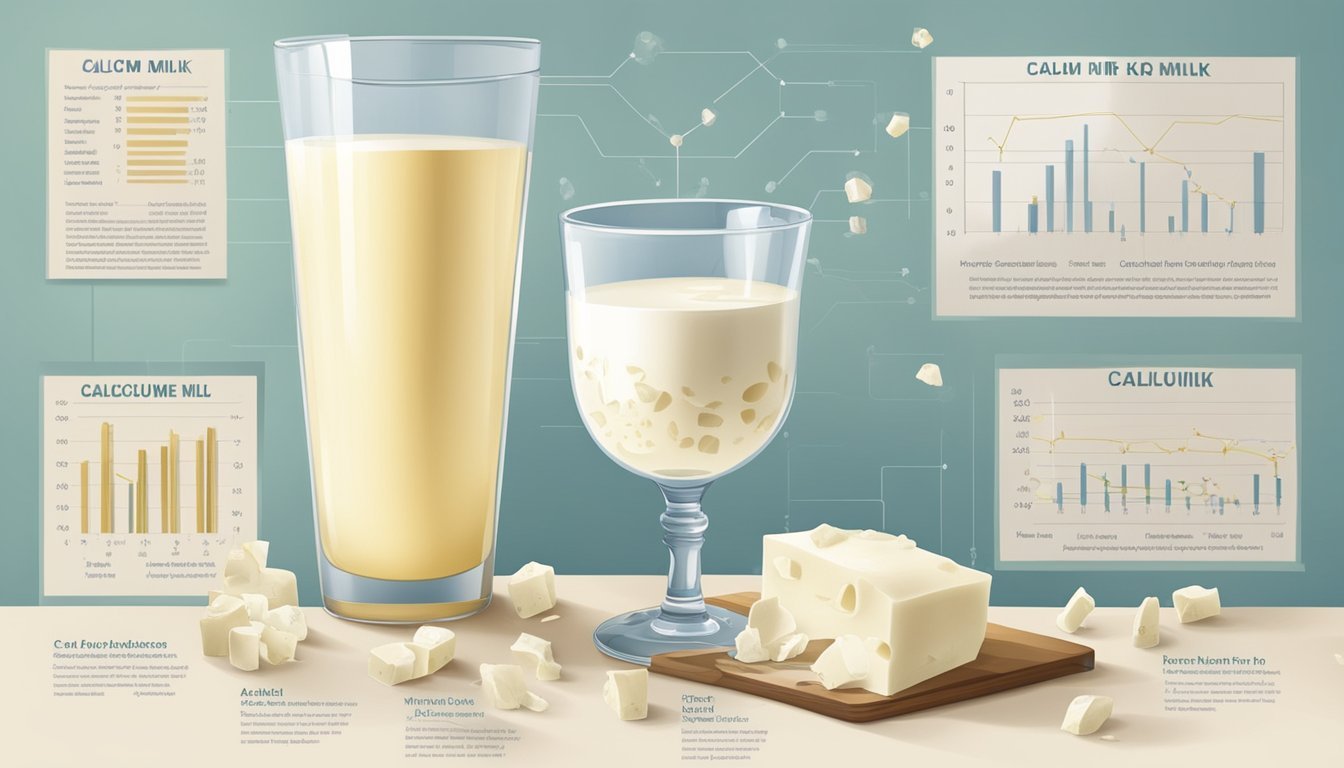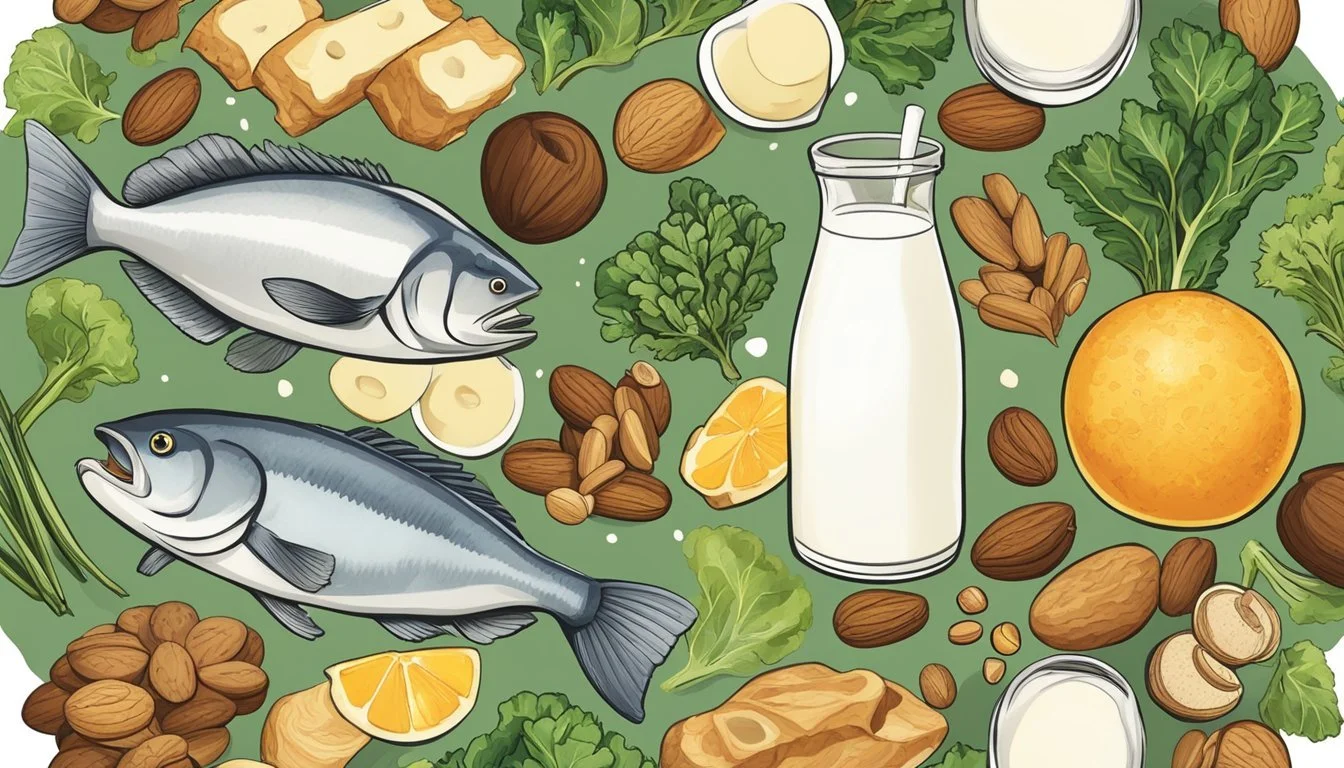The Relationship Between Raw Milk and Bone Health
Unveiling Nutritional Facts and Myths
The consumption of raw milk has long been associated with bone health, given its rich content of nutrients essential for maintaining bone density and strength. Bones require a variety of minerals and vitamins to upkeep their structure, and milk has been traditionally regarded as a powerhouse of calcium, one of the primary minerals necessary for bone formation and maintenance. Protein, another crucial component found in milk, also plays an important role in supporting muscular health and bone integrity. These attributes position milk as a potential dietary aid in the prevention of bone-related conditions, especially when considering the human body's continuous need for these nutrients throughout different life stages.
Despite its nutritional profile, the impact of milk—and specifically raw milk—on bone health has been subject to extensive research and debate. Scientific studies have offered varying conclusions, some asserting the benefits of milk in reducing the risk of bone fractures, while others suggest no significant correlation between milk consumption and bone health improvement. The nuances in research outcomes may also be influenced by factors such as age, hormonal changes, overall diet, lifestyle, and genetic predispositions, which can affect individual nutrient requirements and absorption.
Furthermore, the bioavailability of nutrients in raw milk as opposed to pasteurized milk may differ, prompting considerations about the best sources of dairy for supporting skeletal health. It is crucial for consumers to assess the risk of consuming raw milk, which may contain harmful bacteria, against any nutritional benefits it may bear. Comprehensive examination of the existing literature, along with guidance from healthcare and nutritional experts, is indispensable for individuals seeking to understand the complex relationship between raw milk intake and bone health.
The relationship between raw milk and bone health is a topic of growing interest, particularly in the context of raw milk Paleo diets and the ongoing raw milk industry revolution. Raw milk has been recognized for its potential to contribute to bone health due to its rich content of essential nutrients such as calcium, vitamin D, and protein, which are vital for maintaining strong and healthy bones.
The emphasis on clear and informative raw milk labels further supports this relationship by ensuring that consumers are well-informed about the nutritional value of the raw milk they consume, empowering them to make choices that align with their health goals. Additionally, the potential benefits of raw milk in supporting raw milk immune systems also contribute to overall well-being, indirectly impacting bone health.
Furthermore, the growing presence of raw milk in the raw milk business sector reflects a renewed appreciation for natural, unprocessed dairy products and their potential role in promoting holistic health. As the raw milk renaissance continues to gain momentum, the relationship between raw milk and bone health underscores the intrinsic value of this natural, nutrient-rich source of nourishment in supporting overall well-being.
The Importance of Calcium in Bone Health
Calcium is pivotal in developing and maintaining bone mass, directly affecting bone mineral density. Appropriate calcium intake is critical to prevent bone-related diseases and ensure optimal bone health throughout an individual's lifespan.
Calcium Sources and Bone Density
The relationship between calcium intake and bone mineral density (BMD) is well established. Dietary calcium contributes to achieving peak bone mass and is fundamental in slowing down bone density loss, which is a natural part of aging. Studies have shown that increasing dietary calcium can slightly improve BMD by 0.6-1.8% over one to two years at various sites in the human body.
Key sources of dietary calcium include:
Dairy products (milk, cheese, yogurt)
Fortified foods (juices, cereals)
Leafy greens (kale, broccoli)
Certain fish (sardines, salmon with bones)
Table: Recommended Dietary Allowance for Calcium
Age Group Recommended Calcium Intake (mg/day) 19-50 years 1,000 51-70 years (Men) 1,000 51-70 years (Women) 1,200 71+ years 1,200
Note: Calcium supplements and calcium and vitamin D supplementation can be considered if dietary intake is not sufficient. However, one should seek professional medical advice before starting any supplement regimen.
Dairy Products as a Calcium Provider
Dairy products are a primary source of dietary calcium and play a significant role in maintaining bone health. Milk and dairy products not only provide calcium but also other important nutrients like phosphorus, protein, and vitamin D, which enhance calcium absorption and bone formation. Including low-fat or nonfat dairy products in the daily diet is encouraged.
Fermented dairy products, such as yogurt and kefir, have also been associated with favorable effects on bone health. Not all dairy is equal, though; the calcium content can vary:
Milk (8 oz): approximately 300 mg of calcium
Yogurt (6 oz): 300-400 mg of calcium
Cheese (1.5 oz of hard cheese): 300-400 mg of calcium
These dairy products contribute significantly towards the recommended dietary allowance of calcium. Nevertheless, for individuals with lactose intolerance or dietary preferences that exclude dairy, alternative calcium-rich food sources and supplements may be necessary to meet their calcium needs.
Milk and Its Nutritional Components
Milk is a rich source of several nutrients essential for bone health, including protein, vitamin D (in fortified forms), phosphorus, and other minerals. These elements work synergistically to support bone metabolism and overall skeletal strength.
Protein and Bone Metabolism
Milk provides high-quality protein which is vital for bone strength and repair. The protein in milk primarily comes from two sources: casein and whey. Casein comprises about 80% of milk protein and is known for its slow digestion, providing a steady supply of amino acids. Whey protein, making up the remaining 20%, is recognized for its rapid digestion and the presence of essential amino acids necessary for bone growth and healing processes.
Effects on bone metabolism:
Protein enhances the absorption of calcium into the bones.
It stimulates the production of insulin-like growth factor 1 (IGF-1), which plays a significant role in bone growth and development.
Vitamin D and Phosphorus Content
Milk, particularly when fortified with vitamin D, is a crucial dietary component for bone health due to its role in calcium absorption. Vitamin D-fortified milk improves calcium uptake and bone mineralization. In its natural form, milk supplies a range of vitamins and minerals but not vitamin D unless it has been added.
Vitamin D:
Aids in the regulation of calcium and phosphate levels in the bloodstream.
Essential for the proper remodeling of bone.
Phosphorus, found in milk as phosphate, is another pivotal mineral for bone health.
Phosphate:
Combines with calcium to form the hard structure of the bone, hydroxyapatite.
It plays a role in energy storage and transfer within the body, which indirectly influences bone strength and formation.
The consumption of milk can thus be an important dietary strategy for maintaining bone health throughout life, particularly when it includes these vital nutrients.
Milk Consumption Throughout Life Stages
The consumption of milk from childhood through adulthood plays a pivotal role in the development and maintenance of healthy bones. It is a key factor in achieving peak bone mass and influences long-term bone health.
Milk's Role in Childhood Bone Development
In the critical years of childhood, especially during growth spurts, milk consumption is fundamental to bone development. Studies suggest that children who consume adequate amounts of milk, rich in calcium, magnesium, and protein, are more likely to reach their genetic potential for peak bone mass. Specifically, prepubertal girls who include milk in their diet regularly may support better bone mineralization leading to a solid foundation for bone health.
Calcium: Essential for bone growth, helping to solidify the framework of the bone structure.
Protein: Contributes to the integrity of the bone matrix and supports overall growth.
Magnesium: Facilitates bone metabolism and remodels alongside calcium.
Dairy Intake in Adults and Bone Maintenance
As individuals transition into adulthood, the focus shifts from building bone mass to maintaining it. Bone remodeling, the process where old bone is replaced by new bone, continues throughout life, and adequate dairy intake, including milk, yogurt, and fermented milk products, supplies nutrients essential for this process. Adults who maintain dairy as a part of their daily diet can help to preserve bone mineral mass and bone density, potentially reducing the risk of osteoporosis and related fractures later in life.
Protein Intake: Adults should seek to consume enough protein through dairy to support continuous bone remodeling.
Dairy Products: A variety of dairy products, like yogurt and fermented milk, offer additional nutrients that may aid bone health beyond calcium alone.
Publications indexed in PubMed provide evidence that continuous, adequate milk consumption throughout life may contribute to sustained bone health in adults. While peak bone mass is largely determined during the first three decades of life, ongoing dairy intake is beneficial for bone maintenance as it provides a consistent supply of necessary nutrients.
Bone Health Disorders and Dairy Products
The consumption of dairy products plays a significant role in bone health, influencing the development of disorders such as osteoporosis and the incidence of fractures. This section examines the relationship between dairy intake and these bone health issues, with a focus on specific findings related to osteoporosis and fractures.
Osteoporosis and Dairy Intake
Osteoporosis is characterized by reduced bone mass and deterioration of bone tissue, leading to a heightened risk of fractures. Dairy products, which are rich in calcium and protein, are considered beneficial for bone health and bone homeostasis. Research indicates that adequate dairy intake can contribute to higher bone mineral density (BMD), potentially reducing the risk of developing osteoporosis.
Calcium and Protein: Critical nutrients in dairy such as cheese and milk.
Calcium: Essential for bone health, with dairy providing a significant source.
Protein: Supports bone repair and renewal, with dairy products contributing to dietary protein intake.
Genetic and Nutritional Factors: These also affect bone health, with dairy intake being part of a broader nutritional approach to managing osteoporosis.
Fractures and Dairy Product Consumption
Fractures, particularly osteoporotic fractures and hip fractures, are a major concern for individuals with compromised bone health. Dairy product consumption has been associated with decreased fracture risk by providing nutrients essential for maintaining bone strength.
Fracture Risk: Influenced by multiple factors including dietary intake, with dairy providing key nutrients.
Hip Fracture Risk: Adequate dairy intake has been linked to a lower risk of hip fractures.
Bone Loss: Can be mitigated by a diet inclusive of dairy products, which supply calcium and protein to support bone density.
By considering genetic predispositions and ensuring a balanced intake of nutrients from dairy and other sources, one can take an active role in supporting bone health and potentially mitigating the risk of bone health disorders.
Scientific Studies on Milk and Bone Health
Research has scrutinized the relationship between milk consumption and bone health, utilizing various study designs that encompass observational research, meta-analyses, and controlled trials.
Observational Studies and Meta-Analyses
Observational studies consistently aim to decipher correlations between milk intake and bone health markers. These studies often draw from extensive databases, including Medline, PubMed, and Scopus, to develop comprehensive reviews of existing literature. One meta-analysis observed that adults who supplement their diet with milk exhibit improved bone health indices. This analysis synthesizes results from multiple sources to suggest a positive correlation between milk, which is rich in protein, calcium, and phosphorus, and peak bone mass achievement. Key factors such as dietary intake and physical activity are also considered in these studies to account for confounding variables that might influence bone health.
The methodology of these meta-analyses involves systematic reviews of the literature, with scope clearly defined to target the relationship between milk and aspects of bone health such as bone formation and bone turnover. Some studies pay particular attention to the potential modulation of parathyroid hormone, which plays a crucial role in bone resorption and turnover mechanisms.
Randomized Controlled Trials and Intervention Trials
Randomized Controlled Trials (RCTs) and intervention trials offer a more direct assessment of milk's impact on bone health by controlling variables and monitoring outcomes over time. The trials focus on measuring specific metrics, such as bone mineral density (BMD), to assess bone strength and the risk of osteoporotic fractures. These studies provide strong evidence of causality as opposed to the correlative data often derived from observational studies.
Evidence from such trials suggests that consuming dairy, high in nutrients like vitamin D (when fortified), can maximize bone mass accretion during one's growth period and maintain bone mass during adulthood. Intervention trials might also explore the effects of cultured dairy products, like yogurt and kefir, due to their fermentation process, which can affect lactose metabolism and yield distinctive impacts on bone health.
In conclusion, the data drawn from various scientific studies suggest a complex yet discernible relationship between milk consumption and bone health. The interpretations and recommendations stemming from these studies remain crucial for understanding how dietary choices impact long-term bone health.
Other Nutrients Involved in Bone Strength
Besides calcium and vitamin D, several other nutrients are essential for bone health. They contribute to bone strength, mass accrual, and overall tissue integrity.
Additional Minerals and Bone Structure
Magnesium is a key mineral that contributes to bone strength. It is involved in the formation of bone mineral crystals, which increase the hardness and strength of the bone tissue. Magnesium is found abundantly in nuts, seeds, and green leafy vegetables. Adults require about 320-420 mg of magnesium daily, depending on age and sex.
Potassium also plays a role by neutralizing bone-depleting metabolic acids. Sufficient potassium intake, commonly through fruits and vegetables, can help maintain bone mass.
Calcium Phosphate: This compound is a primary component of hydroxyapatite, which forms bone structure. Adequate intake is necessary for maintaining bone density.
Vitamin and Protein Synergies
Vitamin D is critical for bone health, as it facilitates calcium absorption and bone remodeling. It is either obtained through diet, supplementation, or synthesized in the skin in response to sunlight exposure.
Protein intake is equally vital for bone health. Adequate protein intake supports the repair and maintenance of bone tissue. Additionally, specific peptides derived from protein may play a role in bone strength by influencing calcium absorption and bone formation.
Vitamins: Other essential vitamins for bone health include vitamin A, necessary for bone growth and remodeling, and vitamin K, which supports bone mineralization.
These nutrients work in harmony to ensure the development and maintenance of robust bone structure throughout life.
Lifestyle Factors Influencing Bone Mass
Bone mass is significantly influenced by lifestyle choices, particularly through physical activity and dietary patterns. These factors can either strengthen bone health or increase the risk of fractures and osteoporosis.
The Role of Physical Activity
Physical activity, particularly weight-bearing exercises, plays a critical role in building and maintaining bone mass. High-impact activities such as walking, running, and strength training stimulate bone formation and improve bone density over time. They also enhance muscle strength, balance, and coordination, which can reduce the likelihood of falls and subsequent fractures.
Walking: Beneficial for increasing bone density in the hip.
Strength Training: Helps in improving bone strength and structural integrity.
Dietary Patterns and Bone Density
Dietary patterns have a direct impact on bone density and overall bone health. Adequate calcium intake is paramount for bone formation and maintenance, and dairy products such as milk, cheese, and yogurt are rich in calcium as well as protein, which is necessary for bone repair and health.
Calcium-Rich Foods: Include milk, cheese, yogurt, and fortified plant milks.
Protein Intake: Essential for bone health, found in both animal and plant sources.
Additionally, individuals following vegan diets need to ensure they consume sufficient plant-based sources of calcium and protein. Foods fortified with calcium and vitamin D, and fermented foods (What wine goes well with fermented foods?) containing probiotics, support bone health. It's important for vegans to include foods like tofu, legumes, nuts, and seeds to maintain adequate nutrition for bone maintenance.
Vegan Nutrition: Fortified foods, tofu, legumes, nuts, and seeds for calcium and protein.
Probiotics: Fermented foods may contribute to better absorption of nutrients.
Genetic and Environmental Factors
Bone health is significantly influenced by both genetic makeup and environmental factors. These include the ability to reach optimal bone density and the effectiveness of calcium and vitamin D intake for preventing osteoporosis.
Genetic Influences on Bone Density
Genetics play a crucial role in determining an individual's bone mineral density (BMD). Specific genes are involved in bone formation, with variations in these genes affecting both the maximum peak bone mass an individual can achieve and their susceptibility to osteoporosis. Research indicates that genetic factors can account for up to 60-80% of BMD variation. For example, a gene variant known as LCT-13910 C>T has been studied for its potential association with milk intake and bone health, although results have shown no significant link.
Key Genetic Factors:
Influence on peak bone mass: Genetic makeup
Susceptibility to osteoporosis: Gene variants
Relationship with dietary calcium absorption
Environmental Impact and Nutritional Access
Environmental factors encompass a range of elements that affect bone health, including access to nutrition, lifestyle behaviors, and overall diet. Calcium and vitamin D are two critical nutrients for bone growth, and their availability in one's diet directly impacts bone density. Milk and dairy products are significant sources of these nutrients, with studies suggesting that avoiding dairy in childhood can lead to an increased risk of fractures. Factors like socioeconomic status can influence nutritional access, as can geographical location, affecting sunlight exposure and consequently, vitamin D levels.
Important Environmental Aspects:
Access to nutrients: Calcium and vitamin D intake
Socioeconomic influences: Nutrition and lifestyle choices
Physical activity levels: Positive impact on BMD
Furthermore, lifestyle factors such as physical activity and body mass index (BMI) also contribute to bone health. A sedentary lifestyle or a low BMI may increase the risk factors for reduced bone density and subsequent osteoporosis. Therefore, optimal bone growth and health are best supported by a conducive environment that promotes a balanced diet rich in necessary minerals, regular exercise, and maintenance of a healthy BMI.
Methodological Approaches in Bone Health Research
Research into the relationship between raw milk consumption and bone health involves a variety of methodological approaches aimed at understanding how different factors affect bone remodeling and turnover. Key elements such as calcium and protein intake, the role of vitamin D, and physical activity levels are typically assessed through these methods.
Analyzing Bone Markers
Bone Turnover Markers (BTMs) provide critical insights into bone remodeling processes, which comprise both bone formation and resorption. Markers such as osteocalcin, serum C-terminal telopeptide of type I collagen (CTX), N-terminal telopeptide (NTX), and procollagen type 1 N propeptide (P1NP) are commonly measured. When assessing the impact of raw milk, which is rich in nutrients like calcium and protein, on bone health, researchers look for changes in these markers that may indicate either an increase in bone formation or a decrease in bone resorption.
For instance, variations in levels of osteocalcin, a marker for bone formation, or CTX, indicative of bone resorption, could suggest the efficacy of dietary interventions such as calcium and vitamin D supplementation. Monitoring IGF-1 levels is also beneficial as it's involved in bone growth and development. Methodologically, blood and urine samples are used to assess these biomarkers, providing a non-invasive measure of bone health.
Assessing Dietary and Supplementation Effects
The methodology to evaluate dietary and supplementation effects on bone health generally falls into two categories:
Observational Studies: These studies look at population data over time to find correlations between dietary habits—like raw milk consumption—and bone health outcomes. They might track fracture risk, nutritional intake, and physical activity levels. However, observational studies can be prone to confounding variables and cannot establish causality.
Intervention Trials: These controlled trials are designed to assess the impact of specific interventions, such as calcium supplements or calcium and vitamin D supplementation, on bone health. Participants are provided with a particular dietary regimen, and their bone health is monitored through bone markers and aspects like microarchitectural deterioration related to oxidative stress.
Intervention trials can be further broken down into:
Randomized Controlled Trials (RCTs): Participants are randomly assigned to a treatment group or a control group to determine the effects more accurately.
Cross-over Studies: Participants switch between intervention and control groups at certain intervals, allowing for direct comparison within the same subjects.
To assess the role of raw milk in bone health, these methodologies take into account precise measurements of calcium and protein intake, the influence of other nutritional factors, and the overall balance between bone formation and resorption. They work to isolate the effects of raw milk from other variables that could impact bone health.








